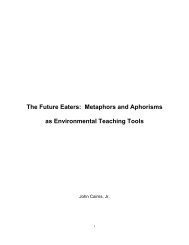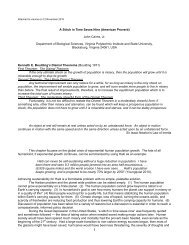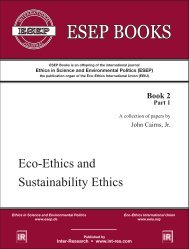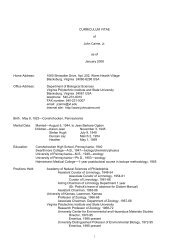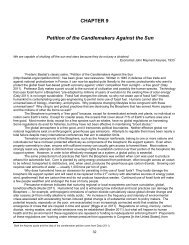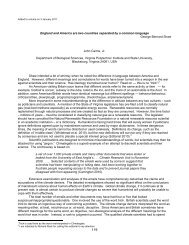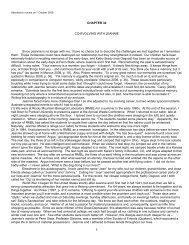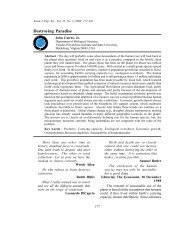View - ResearchGate
View - ResearchGate
View - ResearchGate
Create successful ePaper yourself
Turn your PDF publications into a flip-book with our unique Google optimized e-Paper software.
Article 322751996). The concept of the ecological footprint is a superb means of determining the disparity in thedistribution of Earth’s resources to both individuals and nations.Arguably, the best way to approach the ethical issues involving humankind and Earth’s resourcesis the calculation of an individual’s ecological footprint (e.g. www.lead.org/leadnet/footprint/food.cfm,www.earthday.net/footprint/quiz.asp). In addition, factors that are most important in estimating thesize of an ecological footprint are useful (www.redefiningprogress.org/programs/sustainabilityindicators/ef/faq/).The weighting of factors produces somewhat different footprint sizes. Calculation programsfor estimating ecological footprint size are also available for communities, nations, and so on.Most affluent individuals, especially those in wealthy nations, are shocked at what a large ecologicalfootprint they have. The term affluent is relative. Middle-class Americans would deny beingaffluent, but even a casual perusal of the superbly illustrated book Material World (Menzel 1994) willquickly disabuse them of this illusion. The book’s photographs show the material possessions of across section of families around the globe. For an American, these photographs are disturbing,especially the two on the book’s cover. The text and statistics that accompany the pictures areequally revealing but lack the emotional impact of the photographs.Rees (1996, his figure 2) provides another view of this critical situation. Essentially, the Netherlandsdepends on the ecological productivity of an area nearly 15 times larger than the countryitself. In short, ecological footprint size is not determined by the area occupied, but by the arearequired to maintain the present consumption of resources.Societal action on the ecological footprint information requires both ethics and science. In themiddle of the twentieth century, the established dogma was that ethics and science should notcommingle. I encountered this belief when I began research on water pollution in 1948. Those scientistswith the temerity to deviate from ‘pure science’ were regarded with contempt by some, withamusement and pity by others. However, enough support was available to encourage us. Graduallyover the next half century mainstream science increasingly accepted science and ethics as aconstruct. The crucial relationship between ethics and science began to be recognized, evenapplauded. However, the elation I felt was brief.In some departments of American universities and colleges, science then began to be regardedas just another value judgment. The consilience (literally, leaping together) of ethics and sciencehad been impaired. In addition, in the US, political efforts surfaced to disrupt the scientific process,including peer review; ‘junk science’ was given major attention. This situation has resulted in criticalresponses from such groups as the Union of Concerned Scientists (Meyer 2004) and the graduatestudents and faculty of Stanford University (see www.scienceinpolicy.org/, a document signedby a number of scientists worldwide and discussed in the news media [e.g. Revkin 2004]). The dangersof disrupting and denigrating the scientific process are already apparent. Fortunately, individualscan make ethical decisions based on the verifiable information used in determining ecologicalfootprint size and by using voting and purchasing power to influence both political and corporatepositions.Some illustrative issues involving ecological footprint size follow.1. If one’s ecological footprint is significantly larger than the world average, what action shouldone take? (For the twentieth century, the available per capita ecological space has decreasedfrom 5–6 hectares to approximately 1.5 hectares; the world average is about 1.8 hectares/person[Wackernagel & Rees 1996, pp. 85, their Table 3.4].)2. Should all products and services be labeled to indicate how much they will increase one’secological footprint size?



